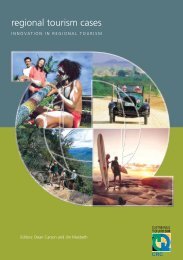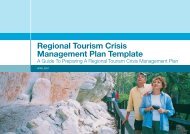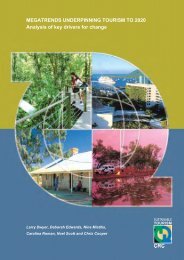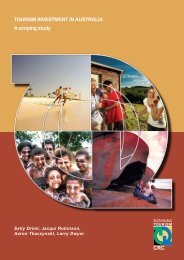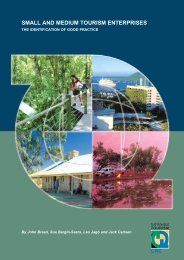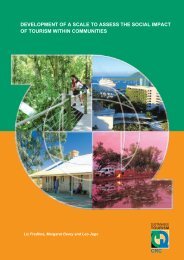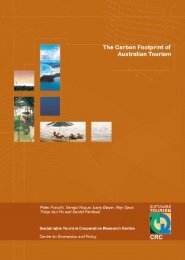Tourism Risk Management - Sustainable Tourism Online
Tourism Risk Management - Sustainable Tourism Online
Tourism Risk Management - Sustainable Tourism Online
You also want an ePaper? Increase the reach of your titles
YUMPU automatically turns print PDFs into web optimized ePapers that Google loves.
The Four Crisis <strong>Management</strong> Strategies<br />
Originally developed by the United Nations Disaster Relief Organization (UNDRO) more than thirty<br />
years ago, the comprehensive crisis management strategies of prevention/mitigation, preparedness,<br />
response and recovery (PPRR) have been widely adopted and provide tourism destinations and<br />
businesses/organizations with a logical, methodical and interlinked approach to crisis management<br />
which has stood the test of time. Although there are variations on the PPRR theme in use (for<br />
example, the four Rs – reduction, readiness, response and recovery), prevention/mitigation,<br />
preparedness, response and recovery is the terminology used in current risk management<br />
processes, and it’s the accepted terminology in disaster management. It is appropriate for this guide<br />
to use PPRR to be consistent with current practices.<br />
PPRR are crisis management strategies, not stages of crisis management. Importantly,<br />
prevention/mitigation and preparedness are continuous processes with no end point. Once a crisis<br />
management plan has been developed, for example, staff have to be trained to the plan, the plan has<br />
to be tested and then revised in light of lessons learned, and staff trained and tested to the revised<br />
plan: planning is an ongoing process.<br />
1. Prevention/Mitigation<br />
Given that these four crisis management strategies are the treatments of residual risk in a risk<br />
management process, risk treatment measures designed to prevent or mitigate (reduce the effects<br />
of) crises should have already been identified and implemented (see Chapter 2). As part of the<br />
process of monitoring and review, however, these should be revisited and new sources of risk to the<br />
tourism business/organization or destination identified and the implementation of risk treatment<br />
measures assessed.<br />
For both the tourism business/organization and destination, an added tool in strategic business<br />
management is the SWOT (Strengths, Weaknesses, Opportunities, Threats) analysis which provides<br />
a structure to identify an organization’s internal strengths and weaknesses, and external<br />
opportunities and threats.<br />
A SWOT analysis used when developing plans and procedures to cope with crises, should focus<br />
upon: strengths, including the resources and support available within a tourism business/organization<br />
and destination to deal with a crisis; weaknesses, the factors which will affect the ability of each to<br />
cope with a crisis and its aftermath; opportunities to enlist government and community involvement<br />
and support to tourism; and threats including the sources of risk to a tourism facility and destination.<br />
(These will already have been identified as part of the tourism risk management process where the<br />
identification of hazards, sources of risk, is a key step in the process. See Chapter 2 for details.)<br />
Occupational Health and Safety<br />
A significant prevention and mitigation measure for crises is to have in place the systems and<br />
procedures necessary to protect the health and safety of visitors and staff. In many countries,<br />
legislation establishes the requirements for occupational health and safety measures to be developed<br />
and maintained, and destinations should identify health and safety requirements to protect visitors<br />
and tourism personnel consistent with national legal requirements, and advise tourism operators on<br />
the development of appropriate plans and procedures.<br />
Consultation between the destination and relevant government departments and emergency services<br />
will ensure that appropriate measures, which comply with national regulations, can be developed and<br />
implemented. Such inter-agency cooperation will also promote an integrated approach to tourism-<br />
52 <strong>Tourism</strong> <strong>Risk</strong> <strong>Management</strong> – An Authoritative Guide to Managing Crises in <strong>Tourism</strong>



